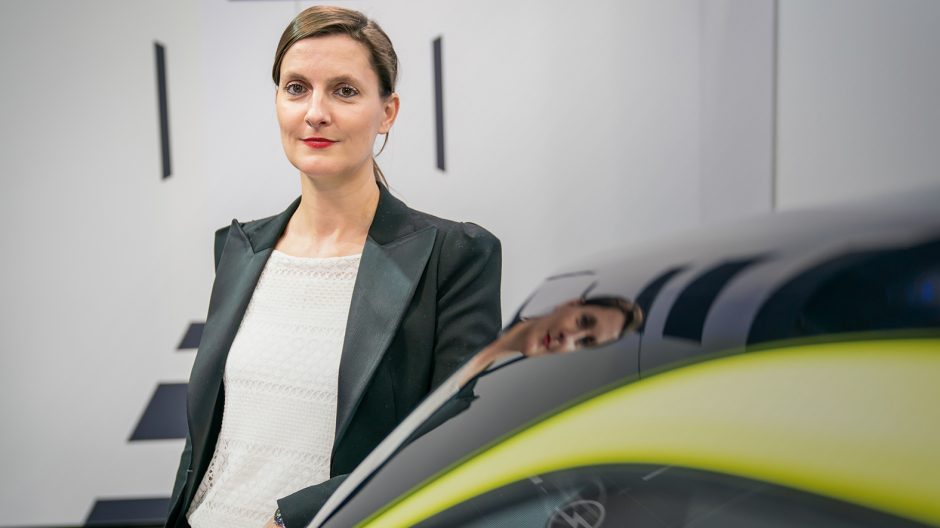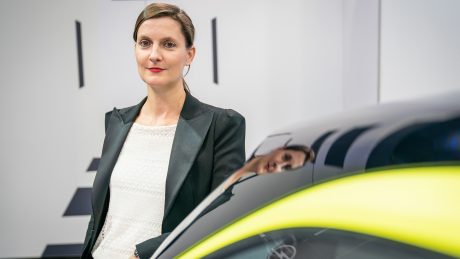“We’re responsible for the colors and materials in the interior and exterior.”
– Belinda Günther –
A compact SUV, fully electric with five doors, and a Coupé feel. It’s full of innovative ideas, too: The Opel GT X Experimental is an impressive glimpse into what we can expect from Rüsselsheim in the future. According to Mark Adams, Vice President Design, the brand study combines “a bold and pure design with advanced technologies that make life simpler.”
Everything from the colors of the interior and exterior to the materials and shapes of the passenger cabin and more all bear the signature of the Color & Trim department. We met with Belinda Günther, the head of the team at the Design Center in Rüsselsheim, to talk about the GT X Experimental, her soft spot for cars, and the work of her team.
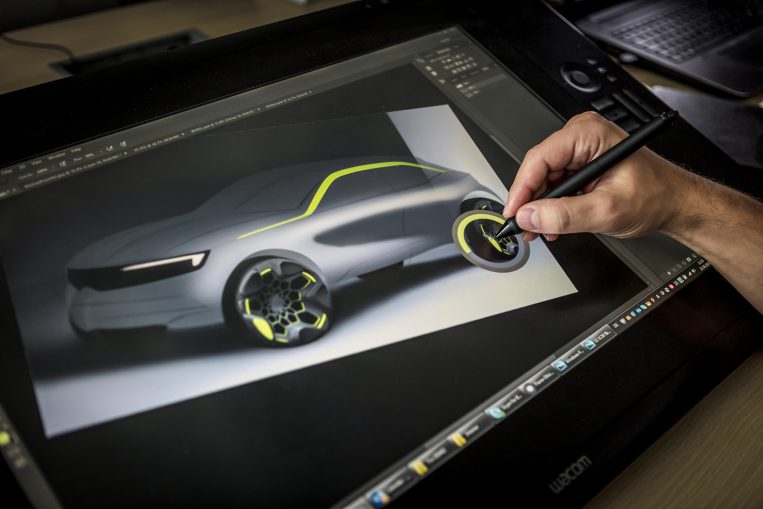
Forward-looking study: Opel provides a glimpse into the future with the GT X Experimental.
Ms. Günther, the GT X Experimental gives us a glimpse into the way Opel will design its models in the future. What was the key objective when you started designing this concept study?
The most important thing was to have a uniform concept for the interior and exterior; the common theme in our ‘Bold and Pure’ design philosophy. With the GT X Experimental, we wanted to pursue a bold and pure design language; one that acknowledges our tradition while simultaneously linking it with the future. I think we’ve done that in a very convincing way.
You’re in charge of the Color & Trim department in Rüsselsheim. What does this involve and what does your team do in general?
We’re responsible for the colors and materials in the interior and exterior, so for example, we decide what colors we offer for the chassis, which material to make the seat covers from, where to place visual accents, and so on. Basically, if you can see it and touch it, it’s our responsibility.
Does smell also play a part?
Yes, of course. There’s a special department that is responsible for the scent of the interior.
Is there a material that has a particular influence on your sense of smell?
Leather is a good example of that. Everyone has come across its distinctive and, provided the leather quality is high, even pleasant aroma at least once. You associate it with class, sometimes with luxury, and also with being close to nature. High-quality leather exudes a sense of softness and signals warmth, while at the same time it remains robust and resilient for many years. Leather’s unique smell partially comes from the material itself, but it’s also the result of the complex tanning and conservation processes it goes through. Once it’s ready, you’ve got yourself one of the most diverse and attractive design materials you could wish for.
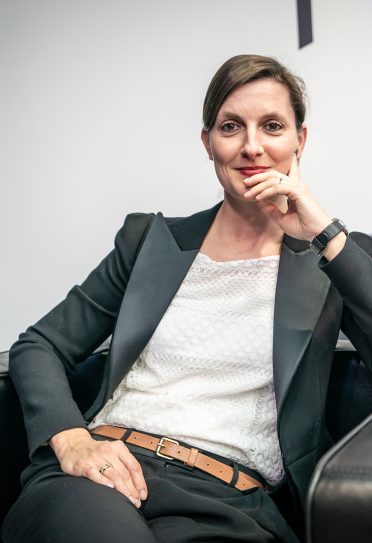
Since May 2003 at Opel: Belinda Günther started as a creative designer in the Color & Trim department and has since gone on to lead the department.

“High-quality leather exudes a sense of softness and signals warmth.”
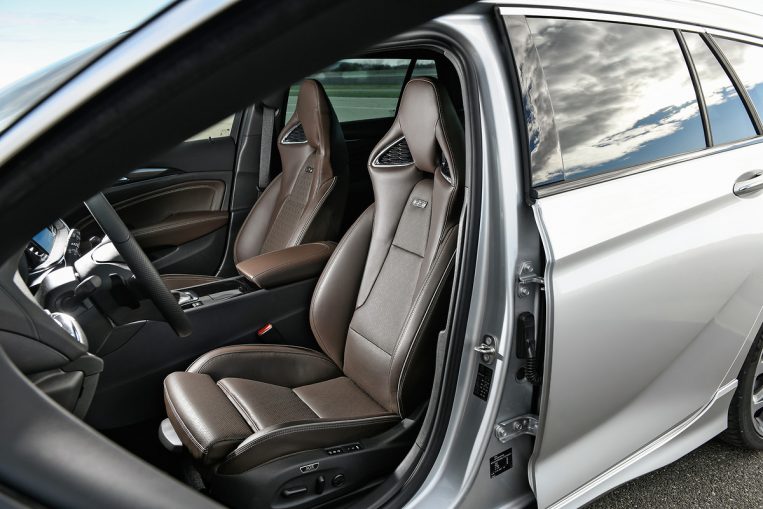
Sporty yet luxurious companions: The leather seats in the Insignia GSi (Sports Tourer), available in Brown Stone, lend the Opel flagship a touch of class.
To what extent are you involved in choosing the leather?
We assess the output from the manufacturer and make our choice based on surface quality, color, and smell.
The GT X Experimental doesn’t contain any leather; instead, you’ve decided to use a structured material as a covering, for example, for the seats. Why is that?
We wanted a modern look inspired by mesh fabrics; in other words, these industrially manufactured knitted fabrics that are also used in sneakers. We create quite deliberate contrasts with these technical-looking elements, mainly on the central section of the seat, and the soft, light surfaces. The welded color accents complete the ‘Bold and Pure’ concept because they allow us to proportion the colors correctly and to be as precise as we want. The seats look sporty but at the same time are tangible and breathable.
A photo series with the GT X Experimental featuring a man and a woman in sporty clothing has been released to support the new, dynamic approach. Speaking of which, do you prefer designing for men or for women?
Good question. (laughs) If I wanted to give the easy answer, I’d say “Opel designs are unisex.” But in all seriousness, we take a different approach when it comes to designing interiors and exteriors. We always have to keep three questions in mind: Who buys our cars? Which target group do we want to address? And what does this group most likely expect from us?
It sounds like you’d need to work together with quite a few experts in the company?
Absolutely. Our department never makes a decision by itself. For example, the color palette we select is the result of a constant dialog with our fellow workers in interior and exterior design, the marketing departments, and, of course, the ME units in the plants. Together, they all shape the framework in which we can offer colors and combinations for a new model.
What does that kind of color palette usually look like?
Every car line has its own set of core colors, which rarely change over the years. They include black, silver, and white. The latter became fashionable again a few years ago; a lot of people wrote it off as just a passing trend, but it’s always one of the most requested colors for the majority of our car lines. There are also the solid colors that are offered at no or for very little extra charge, which we also expect to be requested for a longer period of time. And then, we have the fashionable colors that we swap out maybe every two or four years to make a new statement, provided that one of them doesn’t become an unexpected success, like mahogany brown did for Insignia.
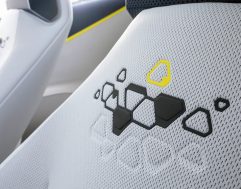
Modern look: The structure of the seats in the GT X Experimental is inspired by the mesh fabric used in sneakers.
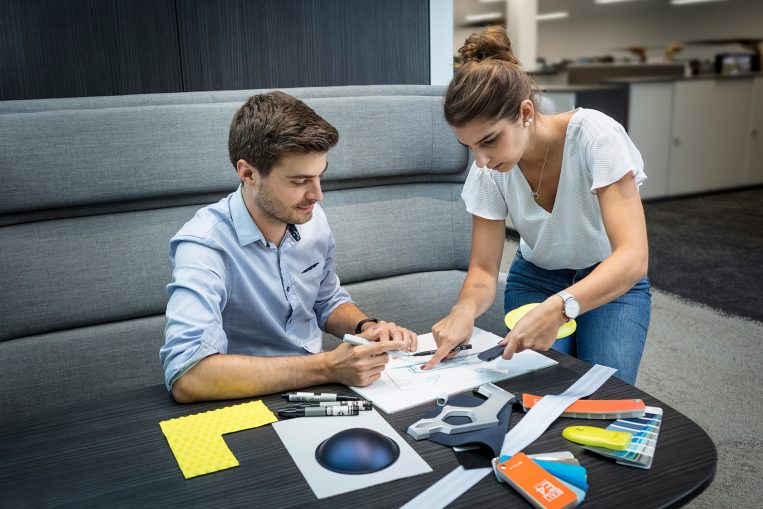
Perfect match: Céline Clement of Color & Trim and Fabien Ory of Advanced Design selecting colours for the GT X Experimental.
You work in the automotive industry, which is a rather male-dominated environment. Does that mean Opel leaves it up to the women to set the trends?
It might look that way at first glance, but it was never intentional. The Color & Trim department has actually emerged as a female domain in more companies than just Opel. The disproportionate number of men in the development and technology departments redresses the proportions.
What do you put the disproportionate number of women in your area down to?
The female inclination towards color and trim is definitely related to general interests in fashion, colors, and fabrics. Women are often quicker to get on board with the latest fashion trends, and they furnish their homes with decorative items, so I’m not really surprised that their interest and pleasure in design is also reflected in the automotive industry.

Thorough examination: Céline Clement, Designer at Color & Trim, compares the effects of different wheel rim colours of the GT X Experimental.
“The Color & Trim department has actually emerged as a female domain in more companies than just Opel.”
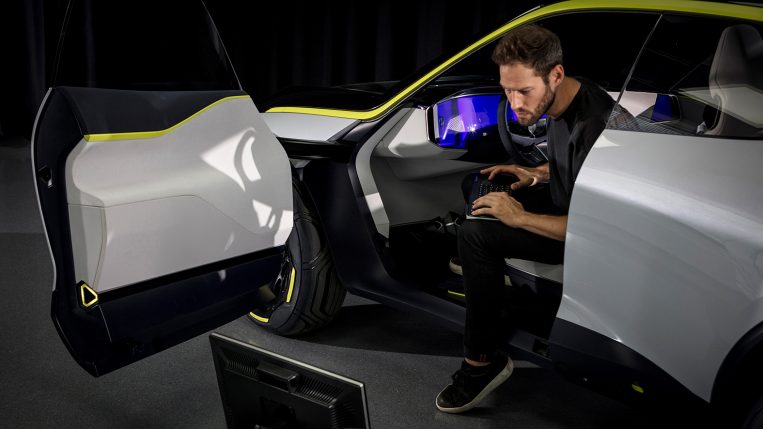
Operate and observe: Creative Designer Matthias Wirth tests the user interfaces between the driver and the machine. The interaction with Human Machine Interface section is, amongst others, particularly important for the Color & Trim team.
But there still must be clear, specialist criteria that you use to put your team together?
Yes, of course. We try to create the ideal criteria using a background that is as technically diverse as possible. More specifically, that means that potential team members have some experience as product, graphic, or color designers. I myself studied fashion design.
And did you work in the fashion industry?
Not quite. My direct link to that ended when I finished my degree. I decided to move into the automotive industry immediately after I graduated. I joined Opel fairly soon after my initial position at Nissan as Color & Trim Designer.
Did you always have a soft spot for cars?
Yes and no. Fast and beautiful cars have always played a major role in my family. That’s why I developed a keen interest in cars when I was young. But I’m not a ‘car maniac.’
Would you go back to the fashion industry if you had the chance?
No way. The diversity and excitement of the automotive industry can’t be beaten. Even now, living in times of radical upheaval in the mobility sector, I can’t imagine a more exciting job. The fun of creative work comes with the challenge of lighting the fire under a brilliant, highly motivated team. In return, they always have new ideas for me to work with. It’s a constant back-and-forth, and the feeling that we’re developing something together as one creative unit is simply fantastic.
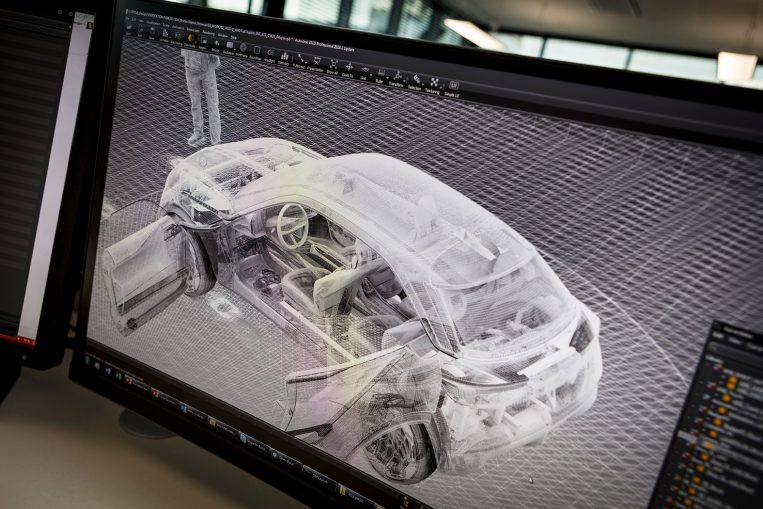
Animation: The GT X Experimental welcomes passengers with spacious, unobstructed access thanks to rear-hinged rear doors and all four doors opening wide to 90 degrees to give the concept an approachable character.
The keyword here is team: How do you ultimately make decisions if there are several potential solutions on the table?
We actually manage to complete the vast majority of tasks as a team. But of course, it’s also exciting to implement your own personal solution now and again and be able to use your creativity to lend a detail a personal touch. That goes for any designer.
How helpful is it to also be able to present your idea for a solution convincingly?
It can work to your advantage, of course, as long as you don’t lose sight of the bigger picture. If that’s the case, we’re already working within a relatively tight framework. Car design doesn’t really have the space for eccentric individualists.
Do you feel it’s difficult to come to a decision?
I wouldn’t call it difficult. It’s more a collaborative process that matures over time with some stops in between. And if the process needs to succeed quickly, we have to understand that it won’t be unless we constantly ask ourselves ‘why am I doing it like that and how do I do it?’
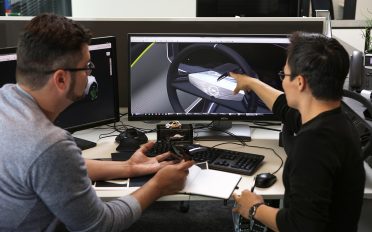
In dialogue: Digital Sculptor Dan Roja (links) and Jay Jongwon Kim, Designer at Advanced Design, analyze a Human Machine Interface simulation of the GT X Experimental’s interior.
“Unlike classical artists, who generally want to create unique works – with emphasis on the word ‘unique’ –, we work on products aimed at a wide and diverse audience.”

Visible from the top-shot-perspective: The sweeping panoramic windscreen/roof reaches far back to the rear seats, enhancing the SUV’s light and open sense of spaciousness.
What’s the biggest difference between artists and designers?
Unlike classical artists, who generally want to create unique works – with emphasis on the word ‘unique’ –, we work on products aimed at a wide and diverse audience. That’s where art and design differ.
Which characteristic embodies a successful designer in a nutshell?
Critical creativity.
Thank you for taking the time to do this interview with us.
“We actually manage to complete the vast majority of tasks as a team.”
February 2019
